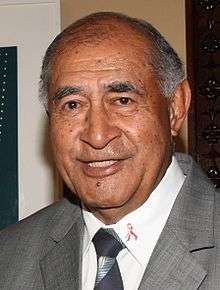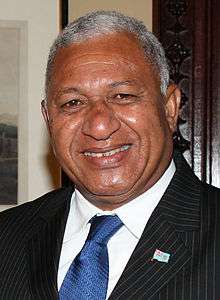Republic of Fiji Military Forces
| Republic of Fiji Military Forces | |
|---|---|
|
Cap badge of the Republic of Fiji Military Forces | |
| Service branches |
Fiji Infantry Regiment Fijian Navy |
| Headquarters | Suva |
| Leadership | |
| Commander-in-Chief | President George Konrote |
| Commander Republic of Fiji Military Forces | Rear Admiral Viliame Naupoto[1] |
| Manpower | |
| Available for military service |
215,104 males, age 18–49 (2005 est), 212,739 females, age 18–49 (2005 est) |
| Fit for military service |
163,960 males, age 18–49 (2005 est), 178,714 females, age 18–49 (2005 est) |
| Reaching military age annually |
9,266 males (2005 est), 8,916 females (2005 est) |
| Active personnel | 3,500 (ranked 146) |
| Reserve personnel | Approx 6,000 |
| Expenditures | |
| Budget | US$96.4 million (2016)[2] |
| Percent of GDP | 2.9% |
| Related articles | |
| Ranks | Military ranks of Fiji |
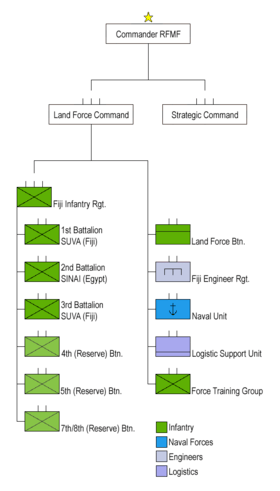
The Republic of Fiji Military Forces (RFMF) is the military force of the Pacific island nation of Fiji. With a total manpower of 3,500 active soldiers and 6,000 reservists, it is one of the smallest militaries in the world, though most of its surrounding island nations have no militaries at all. The Ground Force is organised into six infantry and one engineer battalions, with approximately 6,000 reserves. There was formerly one "Zulu" company of counter-revolutionary specialists, which was deactivated in late 2000 due to a mutiny by some of its members.
The first two regular battalions of the Fiji Infantry Regiment are traditionally stationed overseas on peacekeeping duties; the 1st Battalion has been posted to Lebanon, Iraq, Syria, and East Timor under the command of the UN, while the 2nd Battalion is stationed in Sinai with the MFO. Peacekeepers income represents an important source of income for Fiji. The 3rd Battalion is stationed in the capital, Suva, and the remaining three are spread throughout the islands.
Organisation
- Commander-in-Chief – The President of the Republic is ex officio Commander-in-Chief of the Military Forces.
- Commander RFMF – The Commander RFMF is of two-star rank. He is assisted by the Deputy Commander and the Chief of Staff, who are responsible for Strategic Command and Land Force Command. The current Acting Commander is Rear Admiral Viliame Naupoto following the resignation of Brigadier Mosese Tikoitoga on 2 August 2015.[1][3] Tikoitoga succeeded the previous Commander and current Head of Government Commodore Voreqe (Frank) Bainimarama after fifteen years of service as Commander and a total of thirty-nine years of active military service.[4]
- Strategic Command – Strategic Command is responsible for all of the long term and strategic concerns of the RFMF, including welfare, legal issues, sustainability issues etc.
- Land Force Command – Land Force Command is the operational organisation of the RFMF, and is responsible for all of the main units:
- HQ Land Force Commander Lieutenant Colonel Jone Kalouniwai[5]
- Naval Unit
- Fiji Infantry Regiment
- Regular Force
- 1st Battalion
- 2nd Battalion
- 3rd Battalion
- Territorial Force
- 4th Battalion
- 5th Battalion
- 7th/8th Battalion
- Regular Force
- Fiji Engineer Regiment
- Logistic Support Unit
- Force Training Group
- Presidential Palace Guards
- Fiji Military Forces Band
Equipment
- AK-101[6]
- RPK-201[6]
- PKM[6]
- RPG-7W[6]
- RPO-A[6]
- M16A2 rifle
- Daewoo K2 rifle
- CAR-15 carbine
- 6 x 105 mm static howitzer KH178[7]
- 12 x mortar F2 (L16) 81 mm[8][9]
- Daewoo K3 light machine gun
- M60 Machine Gun
- Toyota Hilux - light transport
- Mobile Mechanical Workshop - on Ural-4320 chassis[10]
- 10 x refurbished Bushmaster Protected Mobility Vehicle[11][12]
Fijian Navy
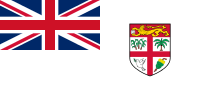
The 300-man Navy Unit RFMF celebrated, on 25 July 2015, the fortieth anniversary of its founding. It was formed in 1975 (Naval squadron Royal Fiji Military Forces), following the government's ratification of the United Nations Law of the Sea convention. The Navy is responsible for maritime needs in border control, such as watching over Fiji's exclusive economic zone and organising task and rescue missions. It currently operates 9 patrol boats. Military aid is received from Australia, the People's Republic of China, and the United Kingdom (although the latter has suspended aid as a result of the 2006 military coup against the civilian government).
Speaking at 30th anniversary celebrations on 26 July 2006, Commander Bradley Bower said that the greatest challenge facing the navy of a maritime country like Fiji was to maintain sovereignty and the maritime environment, to acquire, restore, and replace equipment, and to train officers to keep pace with changing situations.
Equipment
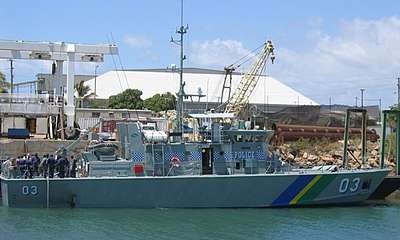
3 Pacific class patrol boat (Australia, displacement 162 t, length 31,5 m, width 8,1 m, draught 1,8 m, power 2 x 1,050 kW, maximal speed 20 knots (37 km/h), crew 17-man, equipment machine guns 1 x 12,7 mm). These boat replace discharged Redwing-class minesweepers FNS Kula, Kikau and Kiro, gain 1975 – 1976 from the United States Navy.
- RFNS 201 Kula (May 1994)
- RFNS 202 Kikau (May 1995)
- RFNS 203 Kiro (October 1995)
2 patrol boat (USA, displacement 97 t, crew 11-man, equipment machine guns 1 x 12,7 mm)
- RFNS 101 Levuika (1987)
- RFNS 102 Lautoka (1987)
4 Dabur class patrol boat (Israel, displacement 39 t, crew 9-man, equipment 2 x cannon 20 mm, 2 x machine guns 7,62)
- RFNS 301 Vai (1991)
- RFNS 302 Ogo (1991)
- RFNS 303 Saku (1991)
- RFNS 304 Saqa (1991)
Fiji Air Wing
The Air Wing of the Republic of Fiji Military Forces, founded in 1987, had a base at the airport in Nausori, but was abolished in 1997. Yehonatan Shimʻon Frenḳel writes that the "Air Wing was formed after the 1987 coup, when the French provided two helicopters as part of its military aid package."[13] Frenkel goes on to say that the air wing was disbanded after both helicopters crashed and after subsequent revelations of huge debts incurred as a result of the aircraft.
The two helicopters were:
- 1 transport helicopter

- 1 transport helicopter

Helicopter AS-365 N2 Dauphin crashed off the coast of the main island in July 1994; a smaller AS-355F-2 continued in service until mid-1997 and in 1999 was sold to France.
The Air Wing did not have its own roundel or ensign and its only marking was the national flag used as a fin flash.[14]
Rank insignia
Political intervention
Fiji's military has a history of political intervention.[17] In 1987, soldiers were responsible for two military coups, and in 2000, the military organised a countercoup to quash George Speight's civilian coup. Since 2000, the military has had a sometimes tense relationship with the Qarase government, and has strongly opposed its plans to establish a Commission with the power to compensate victims and pardon perpetrators of the coup. Among other objections, the military claims that its integrity and discipline would be undermined if soldiers who mutinied in the 2000 upheaval were to be pardoned.
On 4 August 2005, Opposition Leader Mahendra Chaudhry called for more Indo-Fijians, who presently comprise less than one percent of the military personnel, to be recruited. (Specifically, as of October 2007, Fiji's military had 3527 full-time members, of whom only 15 were Indo-Fijians.[18]) This would help guarantee political stability, he considered. He also spoke against government plans to downsize the military. Military spokesman Lieutenant Colonel Orisi Rabukawaqa responded the next day by saying that the military was not an ethnic Fijian body, that it stood to serve the entire nation, and that there was no colour bar in its recruitment or promotion. He said that many Indo-Fijians had been reluctant to commit themselves to a military career because of the slow progress of promotion, often preferring to be discharged and to use their record as a stepping stone to a successful career in some other field. Nevertheless, he appreciated the Indo-Fijian contribution to the military, and noted the success of Lieutenant Colonel Mohammed Aziz, the head of the military's legal unit who was a pivotal figure in the court martial of soldiers who mutinied in 2000. Ironically the rate of promotion of indigenous Fijian officers had been very rapid after the 1987 coup, and subsequent expansion of the Republic of Fiji Military Forces.
On 26 August 2005, the government announced plans to study ways to reduce the size of the military. Military engineers would be transferred to the Regional Development Ministry, said Home Affair Minister Josefa Vosanibola, and the reduction of the military forces would coincide with an increase in the numbers of the police force.
On 26 September 2005, Rabukawaqa revealed that the military had decided to curtail certain operations to stay within its budget. The cuts would affect maritime patrols, search and rescue operations, training and exercises, School Cadet training, and the deployment of military engineers to rural areas. These cuts would be made to ensure that activities accorded a higher priority, such as peacekeeping operations in the Sinai Peninsula and Iraq, officer cadet training with the New Zealand Defence Forces, and the prosecution of soldiers charged with mutiny, would not be affected, Rabukawaqa said.
The next day, Lesi Korovavala, chief executive officer of the Ministry of Home Affairs, told the Fiji Village news service that the military had undertaken the reductions on its own initiative, in consultation with the department, an explanation corroborated by Lieutenant Colonel Rabukawaqa.
On 5 December 2006, the Fijian army staged a third coup d'état. On 7 February 2008, the head of the RFMF and post-coup interim Prime Minister Voreqe Bainimarama stated: "Qarase [...] does not understand the role of the Military and as such is misinforming the nation. [...] [I]f there are practices and policies which have potential to undermine the national security and territorial integrity of Fiji, the RFMF has every right under the Constitution to intervene."[19] In August 2009, with Bainimarama still controlling the government as prime minister and the constitution abrogated, Ratu Epeli Nailatikau, a former military commander, was appointed acting president on the retirement of Iloilo.
Military-church relations
The Military of Fiji has always had a close relationship to Fiji's churches, particularly the Methodist Church, to which some two-thirds of indigenous Fijians belong.
Facilities
- Queen Elizabeth Barracks, Suva
- Walu Bay Naval Base - Located at Narain Jetty in Suva Bay and to be relocated outside of Suva[20]
Commanders
| № | Commander | Took office | Left office | Time in office | Defence branch | Commander-in-Chief | Ref | |
|---|---|---|---|---|---|---|---|---|
| 1 | Brigadier D. J. Aitken | 1971 | 1974 | 2–3 years | Army | Elizabeth II | — | |
| 2 | Colonel Paul Manueli (born 1934) | 1974 | 1979 | 4–5 years | Army | Elizabeth II | — | |
| 3 | Colonel Ian Thorpe | 1979 | 1982 | 2–3 years | Army | Elizabeth II | — | |
| 4 | Colonel Epeli Nailatikau (born 1941) [lower-alpha 1] | 1982 | 1987 | 4–5 years | Army | Elizabeth II | — | |
| 5 | Major general Sitiveni Rabuka (born 1948) [lower-alpha 2] | 1987 | 1992 | 4–5 years | Army | Elizabeth II Himself Penaia Ganilau | — | |
| 6 | Major general Epeli Ganilau (born 1951) | 1992 | 1999 | 6–7 years | Army | Penaia Ganilau Kamisese Mara | — | |
| 7 | Commodore Frank Bainimarama (born 1954) [lower-alpha 2] | 1999 | 2014 | 14–15 years | Kamisese Mara Himself (twice) Josefa Iloilo Epeli Nailatikau | [21] | ||
| 8 | Brigadier Mosese Tikoitoga | 2014 | 31 July 2015 | 0–1 years | Army | Epeli Nailatikau | — | |
| - | Rear Admiral Viliame Naupoto Acting | 1 August 2015 | December 2015 | 4 months | Epeli Nailatikau Jioji Konrote | — | ||
| 8 | Rear Admiral Viliame Naupoto | December 2015 | Incumbent | 2 years, 10 months | Jioji Konrote | — |
See also
Notes
- ↑ Later served as President.
- 1 2 Later served as Prime Minister.
References
- 1 2 "Commander resigns - Fiji Times Online". www.fijitimes.com. Retrieved 28 October 2017.
- ↑ http://www.fiji.gov.fj/getattachment/97c4b8ba-1407-4573-a6f3-a2a8e9d0a4d8/2016---2017-BUDGET-ESTIMATES.aspx
- ↑ Vuibau, Tevita (6 March 2014). "By the book". Fiji Times Online. Retrieved 8 March 2014.
- ↑ Vuibau, Tevita (6 March 2014). "Military pays tribute to 'David'". Fiji Times Online. Retrieved 8 March 2014.
- ↑ "Kalouniwai is Fiji's Military Land Force Commander". Islands Business. 6 March 2014. Retrieved 8 March 2014.
- 1 2 3 4 5 ":: Rosyjska broń dla Fidżi" (in Polish). altair.pl. Retrieved 21 February 2016.
- ↑ "Guns For Fiji - Fiji Sun". fijisun.com.fj.
- ↑ Asia Pacific Defence Reporter 2006 Source Book
- ↑ Ingram-Seal, Leigh. "Republic of Fiji Military Forces" (PDF). Orbat.com. Archived from the original (PDF) on 8 March 2014. Retrieved 8 March 2014.
- ↑ "Next up…Arms Training - Fiji Sun". fijisun.com.fj.
- ↑ Minister for Defence Marise Payne (9 February 2017). "Bushmaster sale another boost to Fiji-Australia defence partnership" (Press release). Department of Defence. Retrieved 27 July 2018.
- ↑ Vakasukawaqa, Arieta (10 February 2017). "Bushmasters For Our Troops". Fiji Sun. Retrieved 27 July 2018.
- ↑ Frenḳel, Yehonatan Shimʻon (2007). From Election to Coup in Fiji: The 2006 Campaign and Its Aftermath. ANU E Press. p. 29. ISBN 0731538129.
- ↑ "Military Flags (Fiji)". www.crwflags.com. Retrieved 28 October 2017.
- ↑ "Fiji Rank Insignia – Army Land Forces". The International Encyclopedia of Uniform Insignia. Retrieved 8 March 2014.
- ↑ "Fiji Rank Insignia – Navy and Coast Guard". The International Encyclopedia of Uniform Insignia. Retrieved 8 March 2014.
- ↑ Appelbaum, Diana Muir (27 August 2012). "How the Sinai Peacekeeping Force Staged a Military Coup in Fiji". Jewish Ideas Daily. Retrieved 8 March 2014.
- ↑ McDonald, Hamish (27 October 2007). "Rumblings of a revolution". Sydney Morning Herald. Retrieved 8 March 2014.
- ↑ "Qarase wrong about military: Bainimarama". Fiji Times. 7 February 2008. Retrieved 8 March 2014.
- ↑ "New Navy Base 'Outside Suva' - Fiji Sun". fijisun.com.fj.
- ↑ Fiji coup leader Frank Bainimarama quits military post for poll run, The Australian, 5 March 2014, accessed 6 March 2014
- Central Intelligence Agency (6 September 2007). "The World Fact Book – Fiji". Retrieved 20 September 2007.
- The International Institute for Strategic Studies (IISS) (2007). The Military Balance 2007. Abingdon: Routledge Journals. ISBN 978-1-85743-437-8.
- http://www.fijitimes.com/story.aspx?id=281772 (purchase of 105 mm howitzers replacing the pounders)

